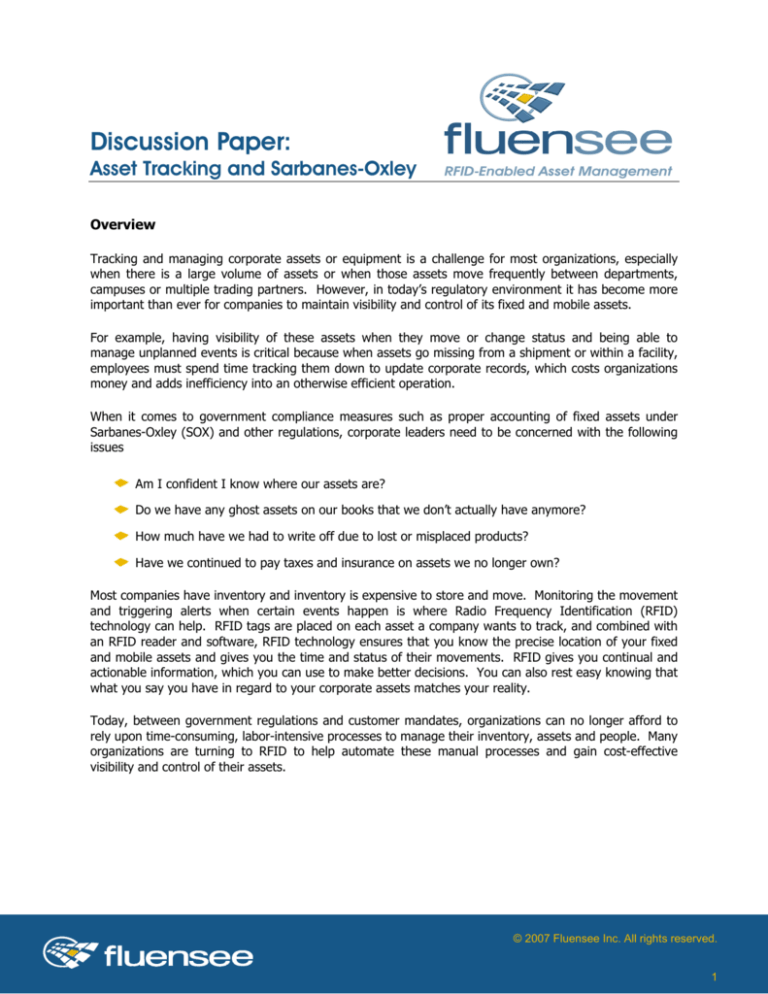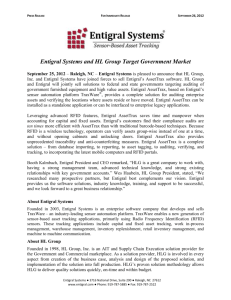
Discussion Paper:
Asset Tracking and Sarbanes-Oxley
Overview
Tracking and managing corporate assets or equipment is a challenge for most organizations, especially
when there is a large volume of assets or when those assets move frequently between departments,
campuses or multiple trading partners. However, in today’s regulatory environment it has become more
important than ever for companies to maintain visibility and control of its fixed and mobile assets.
For example, having visibility of these assets when they move or change status and being able to
manage unplanned events is critical because when assets go missing from a shipment or within a facility,
employees must spend time tracking them down to update corporate records, which costs organizations
money and adds inefficiency into an otherwise efficient operation.
When it comes to government compliance measures such as proper accounting of fixed assets under
Sarbanes-Oxley (SOX) and other regulations, corporate leaders need to be concerned with the following
issues
Am I confident I know where our assets are?
Do we have any ghost assets on our books that we don’t actually have anymore?
How much have we had to write off due to lost or misplaced products?
Have we continued to pay taxes and insurance on assets we no longer own?
Most companies have inventory and inventory is expensive to store and move. Monitoring the movement
and triggering alerts when certain events happen is where Radio Frequency Identification (RFID)
technology can help. RFID tags are placed on each asset a company wants to track, and combined with
an RFID reader and software, RFID technology ensures that you know the precise location of your fixed
and mobile assets and gives you the time and status of their movements. RFID gives you continual and
actionable information, which you can use to make better decisions. You can also rest easy knowing that
what you say you have in regard to your corporate assets matches your reality.
Today, between government regulations and customer mandates, organizations can no longer afford to
rely upon time-consuming, labor-intensive processes to manage their inventory, assets and people. Many
organizations are turning to RFID to help automate these manual processes and gain cost-effective
visibility and control of their assets.
© 2007 Fluensee Inc. All rights reserved.
1
Your Assets and Sarbanes-Oxley
The Sarbanes-Oxley Act of 2002 is a stringent and extensive set of business regulations that seeks to
restore public and investor confidence in public companies by requiring these corporations to create
auditable business processes for improved financial transparency and strong internal operational controls.
SOX regulations mandate that companies comply with a wide range of corporate management and
reporting requirements that lead to significant gains in business performance, executive decision support
and more efficient financial processes.
Complying with SOX means that companies must engage in procedural and cultural practices that ensure
the integrity, accuracy and security of corporate records. It centers on Section 404: Management
Assessment of Internal Controls, which includes three requirements:
Managers are legally responsible for material internal control
Management must attest that the company is controlled, and business and IT processes are
documented
Independent auditors must verify that the company is under control and business and IT
processes are documented
The primary goal of SOX is to prevent fraud and misreporting on financial statements. In regard to
physical and fixed assets, financial statements include assertions stating that the company’s physical
inventory and fixed assets exist and are owned by the company. It attempts to have companies comply
with Sarbanes-Oxley to help prevent costly inventory write-offs and any supply chain events that affect
the balance sheet.
To comply fully with SOX, companies must have complete visibility and traceability of their corporate
assets for better management, accounting and reporting purposes. Companies now have to apply the
same transparency and visibility of hard goods as they do cash. Tracking assets gives corporations the
enhanced ability to accurately monitor and report inventories in a timely manner.
Asset tracking is a real chore for most companies, and if not handled properly, can cause a company a
great deal of money in misplaced items, resulting in high overhead. But technology exists to help
companies automate and streamline the asset tracking and management process. One of those
technologies is RFID and, when used in conjunction with asset tracking software, will offer companies
asset management solutions that help them comply with fixed asset accounting, and therefore SarbanesOxley.
-2-
© 2007 Fluensee Inc. All rights reserved.
2
2
Using RFID to Track Assets and Comply with SOX
RFID technology and asset tracking software tracks the physical location and movement of assets and
inventory. RFID can help track the installation, maintenance, upgrade, movement and decommissioning
of fixed assets. It also can monitor a “chain of custody” through the manufacturing and distribution
process. Essentially, RFID can help companies establish an audit trail of ownership rights and physical
location, which can help companies better account for their assets.
In a nutshell, companies can use RFID technology to assign each asset with a unique item number that
can be stored in a company’s database to provide a complete asset lifecycle history. From then on, every
assigned asset can contain information such as its acquisition date, location, current value, billed account,
warranty, purchase order, contract maintenance, insured value and depreciation schedule.
Using RFID technology, businesses can create a complete, low cost, real-time asset management system
that ensures performance and reliability. Industries like manufacturing, utilities, high-tech, retail,
construction and government can all benefit from the RFID technology to track, trace and know their
real-time asset information.
Compatible with SOX compliance for better inventory management, reduced losses, and improved
customer responsiveness, RFID is the technology with the potential to significantly impact your bottom
line – from increased supply chain efficiencies to reduced inventory write-offs.
Other Uses of RFID to Track Assets
RFID’s asset tracking technology can help companies in the areas of:
Better inventory control
Improved fixed asset accounting
Mobile equipment tracking
Security of sensitive, high-value assets
Raw materials and work-in-progress tracking on shop floors
Personnel identification and access for secured access
Finished goods tracking in manufacturing supply chains
Asset tracking solutions using RFID help organizations to effectively manage their physical assets and
keep a precise inventory of what assets they own and how those assets are being used throughout their
lifecycles.
-3-
© 2007 Fluensee Inc. All rights reserved.
3
3
RFID technology provides vital solutions for the real-time location of critical assets. Companies can use
RFID to reduce their operating costs by improving asset tracking solutions which decreases shrinkage,
lowers labor costs and optimizes asset utilization. When used in conjunction with the right asset tracking
software, RFID even has the ability to alert employees when an asset is not in its designated location,
enabling you to effectively manage, analyze and plan asset utilization and deployment.
The main benefits of an RFID solution that automatically tracks and manages assets are:
Continuous, real-time inventory that can easily be matched to books and which results in fewer
write-offs and increased tax savings
Management dashboards and reports to help determine key performance indicators and increase
asset utilization
Comprehensive asset histories and audit trails reduce errors in recording asset movements and
statuses
Reduced equipment loss or theft due to management alerts when assets aren’t where they
should be
Automated processes that result in significant labor savings
The high storage capacity of RFID tags provides space for critical asset maintenance data that is
transmitted through the reader to management applications. In addition to operational efficiency and
improved asset utilization, RFID technology also aids financial auditing and reporting for better
compliance with Sarbanes-Oxley Act.
About Fluensee
Fluensee’s RFID-enabled asset tracking and supply chain management solutions improve the visibility,
accuracy, security and utilization of a company’s mobile and fixed assets. Its end-to-end solutions
combine highly configurable and patented software and implementation services with hardware from
leading RFID, barcode, GPS and sensor technology providers. Real-time asset location, condition and
alerts result in a more efficient use of inventory, improved utilization and reduced operating costs.
Formerly Applied Logistics, Fluensee is a privately held company with headquarters in Englewood,
Colorado. On the Net: www.fluensee.com.
For more information on RFID-enabled asset management for education, please contact:
Fluensee
Denver, Colorado | (303) 799-0702 | www.fluensee.com
-4-
© 2007 Fluensee Inc. All rights reserved.
4
4









